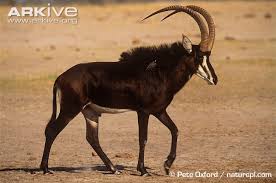Post by dinosauria101 on Jun 19, 2019 17:28:02 GMT 5
Gemsbok - Oryx gazella
The gemsbok or gemsbuck (Oryx gazella) is a large antelope in the Oryx genus. It is native to the arid regions (for example the Kalahari Desert) of southern Africa. Gemsbok are light brownish-grey to tan in colour, with lighter patches to the bottom rear of the rump. Their tails are long and black in colour. A blackish stripe extends from the chin down the bottom edge of the neck through the join of the shoulder and leg along the lower flank of each side to the blackish section of the rear leg. They have muscular necks and shoulders and their legs have white 'socks' with a black patch on the front of both the front legs and both genders have long straight horns. Comparably, the East African Oryx lacks a dark patch at the base of the tail, has less blackish on the legs (none on the hindlegs), and less blackish on the lower flanks. Gemsbok are about 1.2 metres (3 ft 11 in) at the shoulder, and males can weigh between 220–250 kilograms (490–550 lb) while females weigh 180–210 kilograms (400–460 lb). Gemsbok are widely hunted for their spectacular horns that average 85 centimetres (33 in) in length.

Sable Antelope - Hippotragus niger
The sable antelope (Hippotragus niger) is an antelope which inhabits wooded savannah in East Africa south of Kenya, and in Southern Africa, with a population in Angola. The sable antelope is sexually dimorphic, with the male heavier and about one-fifth taller than the female. The head-and-body length is typically between 190 and 255 cm (75 and 100 in). Males reach about 117–140 cm (46–55 in) at the shoulder, while females are slightly shorter. Males typically weigh 235 kg (518 lb) and females 220 kg (490 lb). The tail is 40–75 cm (16–30 in) long, with a tuft at the end. Sable antelope live in savanna woodlands and grasslands during the dry season, where they eat mid-length grasses and leaves. They visit salt licks and have been known to chew bones to collect minerals. They are diurnal, but are less active during the heat of the day. They form herds of 10 to 30 females and calves led by a single male, called a bull. Males fight among themselves; they drop to their knees and use their horns.

Credit to Wikipedia
The gemsbok or gemsbuck (Oryx gazella) is a large antelope in the Oryx genus. It is native to the arid regions (for example the Kalahari Desert) of southern Africa. Gemsbok are light brownish-grey to tan in colour, with lighter patches to the bottom rear of the rump. Their tails are long and black in colour. A blackish stripe extends from the chin down the bottom edge of the neck through the join of the shoulder and leg along the lower flank of each side to the blackish section of the rear leg. They have muscular necks and shoulders and their legs have white 'socks' with a black patch on the front of both the front legs and both genders have long straight horns. Comparably, the East African Oryx lacks a dark patch at the base of the tail, has less blackish on the legs (none on the hindlegs), and less blackish on the lower flanks. Gemsbok are about 1.2 metres (3 ft 11 in) at the shoulder, and males can weigh between 220–250 kilograms (490–550 lb) while females weigh 180–210 kilograms (400–460 lb). Gemsbok are widely hunted for their spectacular horns that average 85 centimetres (33 in) in length.

Sable Antelope - Hippotragus niger
The sable antelope (Hippotragus niger) is an antelope which inhabits wooded savannah in East Africa south of Kenya, and in Southern Africa, with a population in Angola. The sable antelope is sexually dimorphic, with the male heavier and about one-fifth taller than the female. The head-and-body length is typically between 190 and 255 cm (75 and 100 in). Males reach about 117–140 cm (46–55 in) at the shoulder, while females are slightly shorter. Males typically weigh 235 kg (518 lb) and females 220 kg (490 lb). The tail is 40–75 cm (16–30 in) long, with a tuft at the end. Sable antelope live in savanna woodlands and grasslands during the dry season, where they eat mid-length grasses and leaves. They visit salt licks and have been known to chew bones to collect minerals. They are diurnal, but are less active during the heat of the day. They form herds of 10 to 30 females and calves led by a single male, called a bull. Males fight among themselves; they drop to their knees and use their horns.
Credit to Wikipedia





